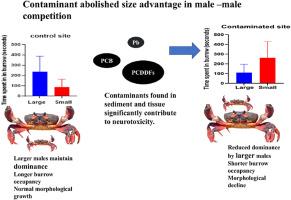在野外条件下,污染物会影响性选择的雄性-雄性竞争成分的结果
IF 7.3
2区 环境科学与生态学
Q1 ENVIRONMENTAL SCIENCES
引用次数: 0
摘要
达尔文的交配前性内选择理论指出,个体为了繁殖成功而竞争配偶。体型优势是动物物种间雄性竞争的关键因素,决定了优势、资源获取、身体竞争的结果和繁殖机会。因此,在进化过程中,这种体型被夸大了。尽管对金属的生理影响进行了广泛的研究,但对这些污染物如何影响生殖和性选择的关键行为,特别是对信号蟹的影响,关注较少。从对照地点、斯旺西和三个受污染地点(鲍威尔溪、八度红树林和二百百年纪念公园)收集螃蟹,并在大小匹配和大小不对称的雄性雄性竞争中配对,以进入洞穴,这是繁殖的关键资源。结果表明,来自污染水平较高地区的个体在竞争相互作用中的成功程度较低,在洞穴中花费的时间少于来自控制地区的个体。此外,虽然来自控制区域的体型较大的雄性在二元相互作用中始终胜过体型较小的雄性,但在受污染区域,体型较小的雄性往往赢得洞穴所有权,这种尺寸优势显着降低。此外,形态学测量显示,污染地点铅、二恶英和多氯联苯浓度的升高与雄性体型和螯合物大小呈负相关,尤其是在成熟紫色雄性中。结果表明,在污染胁迫下,雄性对大体型的选择压力可能会有所放松。这项研究也为我们之前的实验室发现提供了现场证据,这些发现强调了暴露于铅污染对雄性竞争结果的影响,这是信号蟹无性选择的一个组成部分。本文章由计算机程序翻译,如有差异,请以英文原文为准。

Contaminants influence the outcomes of the male-male competition component of sexual selection under field conditions
Darwin's theory of precopulatory intrasexual selection states that individuals compete for access to mates for reproductive success. Size advantage is a critical factor in male-male competition across animal species, determining dominance, access to resources, the outcome of physical contests, and reproductive opportunity. As a result, this body size becomes exaggerated over evolutionary time. Despite extensive research on the physiological effects of metals, there has been less focus on how these contaminants impact behaviours critical for reproduction and sexual selection, particularly in Semaphore crabs. Crabs were collected from a control location, Swansea, and three contaminated locations (Powells Creek, Badu Mangrove and Bicentennial Park) and were paired in size-matched and size-asymmetric male-male competition contests for access to a burrow, a critical resource for reproduction. The results showed that individuals from locations with elevated contamination were less successful in competitive interactions, spending less time in the burrow than individuals from the control location. Additionally, while larger males from the control location consistently outcompeted smaller males in dyadic interactions, this size advantage was significantly reduced at contaminated locations, where smaller males more often won burrow ownership. Furthermore, morphological measurements revealed elevated concentrations of Pb, Dioxins, and PCBs at contaminated locations were correlated negatively with male body size and chela size, especially in mature purple males. The results demonstrated that selection pressure on large size may be relaxed in males under contaminant stress. This research also provides field evidence supporting our previous laboratory findings, which highlight the influence of exposure to lead contamination on the outcome of male-male competition, a component of intrasexual selection in Semaphore crabs.
求助全文
通过发布文献求助,成功后即可免费获取论文全文。
去求助
来源期刊

Environmental Pollution
环境科学-环境科学
CiteScore
16.00
自引率
6.70%
发文量
2082
审稿时长
2.9 months
期刊介绍:
Environmental Pollution is an international peer-reviewed journal that publishes high-quality research papers and review articles covering all aspects of environmental pollution and its impacts on ecosystems and human health.
Subject areas include, but are not limited to:
• Sources and occurrences of pollutants that are clearly defined and measured in environmental compartments, food and food-related items, and human bodies;
• Interlinks between contaminant exposure and biological, ecological, and human health effects, including those of climate change;
• Contaminants of emerging concerns (including but not limited to antibiotic resistant microorganisms or genes, microplastics/nanoplastics, electronic wastes, light, and noise) and/or their biological, ecological, or human health effects;
• Laboratory and field studies on the remediation/mitigation of environmental pollution via new techniques and with clear links to biological, ecological, or human health effects;
• Modeling of pollution processes, patterns, or trends that is of clear environmental and/or human health interest;
• New techniques that measure and examine environmental occurrences, transport, behavior, and effects of pollutants within the environment or the laboratory, provided that they can be clearly used to address problems within regional or global environmental compartments.
 求助内容:
求助内容: 应助结果提醒方式:
应助结果提醒方式:


